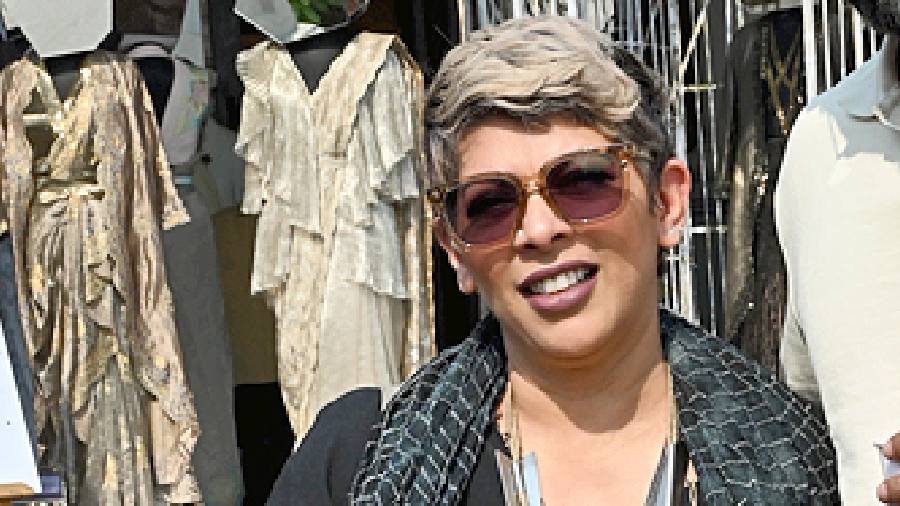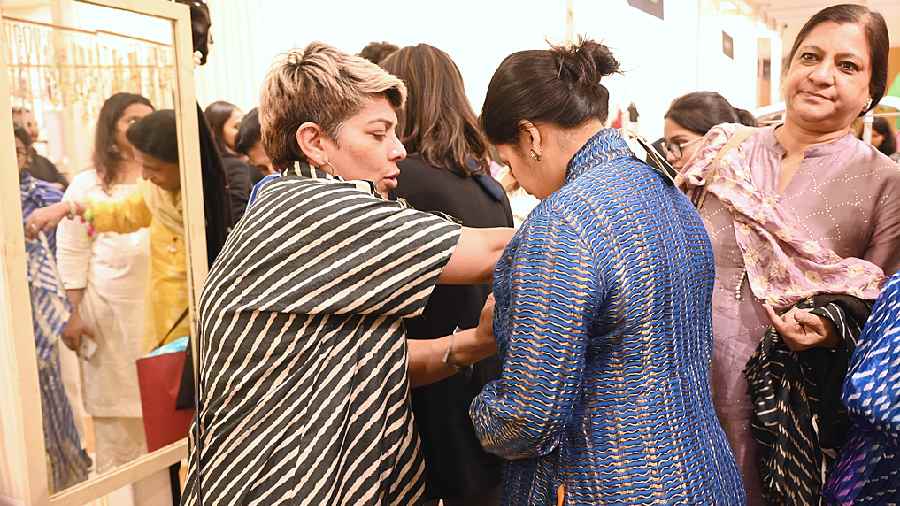Label Urvashi Kaur has been synonymous with the idea of reinventing heritage craft for the contemporary generation. Its newly launched collection ‘Kai’ celebrates the same spirit through striking leheria craft. Deviating from monochrome, dark and solid colour palette usually featured by the label, Kai is an occasionwear range featuring a host of vibrant colours, adding to the spirit of celebrations. The Telegraph caught up with the designer at The India Story to delve deep into the creation of the collection:
What was the highlight of your showcase at TIS this year?
We showcased our latest collection Kai. It is a celebration of leheria, the dye craft from Jaipur. It has bold colours and patterns on the brand’s signature silhouettes and is more playful, fun and festive. We have used textiles from Kota silk to tussore silk to tissues. The metallic element gives the whole collection a luxurious festive vibe. We have paired them with solids, chanderi and kept the collection more contemporary, festive and fusion almost. With the label’s versatile separates, multiple options, layering and keeping with the brand aesthetics, the collection is all about functionality.
Leheria is a heritage craft. What inspired you to work with this craft?
I love tie-dye and different forms of tie-dye. What I love about leheria or Mothra tie-dye craft is the pattern that it creates. The linearity and the diagonal lines are like an illusion and it is done very painstakingly. Not consistently done from one place to another since it is done with hands. It is very fine and will open up depending on how the textile is tied. The intricacy of the craft having the ombres and mix of colours really lend to the mix of silhouettes. It gives it another dimension. I like that geometry, anything that’s linear. And, I love the fabric as I am able to play with that.

Urvashi Kaur
Can you take us through the journey of reintroducing this heritage craft on modern silhouettes for contemporary tastes?
I think it is fascinating to give everybody a new way of looking at something that is very traditional. We are creating for a more global consumer, somebody who is not defining this craft within boundaries or geographies. From contemporising and using them in colours that are non-traditional or even in textiles that are nontraditional, it gives a very fresh take. People nowadays have more of an individual style. I don’t like to create sets from top to toe. I like to create sets that they would wear based on their personality types and what would work for them. Then they really resonate with the design and make it their own. The idea is to really do that rather than them trying to portray how I would like my customers to be like. It is really about portraying individual style, it gives people versatility. They wear it with something they have in their wardrobe.
We are also talking about wearing it in so many different ways. Every time you wear it differently, you are getting so much wearability for the money you spend. You are not buying for a limited occasion. It is occasionwear but not just for occasions. The idea is to keep telling people that you are buying something that will last a lifetime. We are supporting artisansand cannot let it become a dying art. With screen printing and everything, everyone is now creating printed versions of leheria. This way the art of leheria will die. It is important that we make consumers aware of keeping the system alive. We say you repeat it in different ways. That’s how we need to make people realise. It is difficult because people don’t understand that it is a craft. People think it is a print. So, a lot of education goes into it.
It is also about championing the cause of sustainability through wearability, right?
I also upcycle. I tell my clients that they have a ton of saris that they have not worn. They can bring them, I can upcycle them. These are textiles passed down through generations. It is about making them explore what they can do with old textiles. I created a woollen collection with hand-painting and dabu dyeing. It is like telling them this is exclusive, this feels great on your skin. Just like eating better and sleeping better, it is about wearing clothes that are made of natural fibres and have this wellbeing aspect about them that is good for our skin and minds.
The collection looks like a celebration in itself with such bright colours…
Yes, it is a departure from what the brand usually does. I don’t do a lot of colours, but I was tempted to infuse that colour because we do like to keep in mind what customers want from the brand as well. To explore that within our vocabulary of design is a fun departure.
